ကျူးဘားဒုံးပျံအရေးအခင်း
ကျူးဘားနိုင်ငံတွင် အောက်တိုဘာအရေးအခင်းဟုအမည်တွင်ပြီး ဆိုဗီယက်ပြည်ထောင်စုတွင် ကာရေဘီယံအရေးအခင်း(Caribbean crisis) (ရုရှား: Карибский кризис, tr. Karibskiy krizis) ဟု အမည်တွင်သည့် ကျူးဘားဒုံးပျံအရေးအခင်းသည် ၁၉၆၂၊ အောက်တိုဘာတွင် ဆိုဗီယက်ပြည်ထောင်စုနှင့်ကျူးဘားနိုင်ငံကတစ်ဖက်၊ အမေရိကန်ပြည်ထောင်စုကတစ်ဖက် ၁၃ရက်ကြာရန်စောင်ကြသော အရေးအခင်းဖြစ်သည်။ ၎င်းသည်စစ်အေးတိုက်ပွဲ၏အဓိကထိပ်တိုက်ရင်ဆိုင်မှုများအနက်တစ်ခုဖြစ်ပြီးယေဘုယျအားဖြင့်စစ်အေးတိုက်ပွဲသည်နျူကလီးယားပဋိပက္ခခသို့အသွင်ပြောင်းရန်နီးကပ်လာသည့်အချိန်ဟုမှတ်ယူကြသည်။ (MAD) ကိုနိုင်ငံတကာလက်နက်သဘောတူညီချက်တွင်အဆုံးအဖြတ်ပေးသောအချက်တစ်ခုအဖြစ်ဆွေးနွေးနေကြသည်။.[2][3]
| ကျူးဘားဒုံးပျံ အရေးအခင်း | |||||||
|---|---|---|---|---|---|---|---|
| စစ်အေးတိုက်ပွဲ၏ တစ်စိတ်တစ်ပိုင်း | |||||||
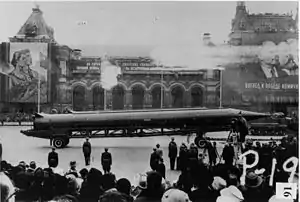 CIA reference photograph of Soviet R-12 intermediate-range nuclear ballistic missile (NATO designation SS-4) in Red Square, Moscow | |||||||
| |||||||
| စစ်ရင်ဆိုင်သည့် နိုင်ငံများ | |||||||
|
|
တမ်းပလိတ်:နိုင်ငံ စာရင်းအင်း ဆိုဗီယက် ပြည်ထောင်စု | ||||||
| တပ်မှူးများနှင့် ခေါင်းဆောင်များ | |||||||
|
|
| ||||||
| အသေအပျောက် | |||||||
|
1 aircraft shot down 1 aircraft damaged 1 pilot killed | |||||||
After provocative political moves and the failed US attempt to overthrow the Cuban regimeအကျင့်ပျက်ခြားစားသော နိုင်ငံရေးလှုပ်ရှားမှုများနှင့် ကျရှုံးနေသော အမေရိကန်ပြည်ထောင်စုသည် ကျူဘားအစိုးရအား ဖြိုဖျက်ရန် ကြိုးပမ်းခဲ့ပြီးနောက်(Bay of Pigs, Operation Mongoose), ၁၉၆၂ မေလတွင် Nikita Khrushchevခရူးရှက်သည်အမေရိကန်၏အနာဂတ်ကျူးကျော်မှုများမှကာကွယ်ရန် ဆိုဗီယက်နျူဒုံးကျည်များကို ကျူးဘားတွင်ထားရှိရန်အဆိုပြုခဲ့သည်. During a meeting between Khrushchev and Fidel Castro that July, a secret agreement was reached and construction of several missile sites began in the late summer. These preparations were noticed, and on 14 October a US U-2 aircraft took several pictures clearly showing sites for medium-range and intermediate-range ballistic nuclear missiles (MRBMs and IRBMs) under construction. These images were processed and presented on October 15, which marks the beginning of the 13-day crisis from the US perspective.
The United States considered attacking Cuba via air and sea, but decided on a military blockade instead, calling it a "quarantine" for legal and other reasons.[4] The US announced that it would not permit offensive weapons to be delivered to Cuba, demanded that the Soviets dismantle the missile bases already under construction or completed, and return all offensive weapons to the USSR. The Kennedy administration held only a slim hope that the Kremlin would agree to their demands, and expected a military confrontation.
On the Soviet side, Premier Nikita Khrushchev wrote in a letter from October 24, 1962 to President John F. Kennedy that his blockade[4] of "navigation in international waters and air space" constituted "an act of aggression propelling human kind into the abyss of a world nuclear-missile war".[5] However, in secret back-channel communications the President and Premier initiated a proposal to resolve the crisis. While this was taking place, several Soviet ships attempted to run the blockade, increasing tensions to the point that orders were sent out to US Navy ships to fire warning shots and then open fire. On 27 October a U-2 was shot down by a Soviet missile crew, an action that could have resulted in immediate retaliation from the Kennedy crisis cabinet, according to Secretary of Defense McNamara's later testimony. However, in the event itself, Kennedy stayed his hand and the negotiations continued.
The confrontation ended on October 28, 1962,[6] when Kennedy and United Nations Secretary-General U Thant reached an agreement with Khrushchev. Publicly, the Soviets would dismantle their offensive weapons in Cuba and return them to the Soviet Union, subject to United Nations verification, in exchange for a US public declaration and agreement never to invade Cuba. Secretly, the US agreed that it would dismantle all US-built Jupiter IRBMs deployed in Turkey and Italy.
After the removal of the missiles and Ilyushin Il-28 light bombers, the blockade[4] was formally ended at 6:45 pm EDT on November 20, 1962. An additional outcome of the negotiations was the creation of the Moscow–Washington hotline, a direct communications link between Moscow and Washington, D.C.
အမေရိကန်ပြည်ထောင်စု၏ရှေးဦးပိုင်းဆောင်ရွက်ချက်များ
The United States was concerned about the Soviet expansion of Communism, but for a Latin American country to ally openly with the USSR was regarded as unacceptable, given the US-Soviet enmity since the end of World War II in 1945. Such an involvement would also directly defy the Monroe Doctrine; a United States policy which, while limiting the United States' involvement with European colonies and European affairs, held that European powers ought not to have involvement with states in the Western Hemisphere.
The United States had been embarrassed publicly by the failed Bay of Pigs Invasion in April 1961, which had been launched under President John F. Kennedy by CIA-trained forces of Cuban exiles. Afterward, former President Eisenhower told Kennedy that "the failure of the Bay of Pigs will embolden the Soviets to do something that they would otherwise not do."[7]:10 The half-hearted invasion left Soviet premier Nikita Khrushchev and his advisers with the impression that Kennedy was indecisive and, as one Soviet adviser wrote, "too young, intellectual, not prepared well for decision making in crisis situations ... too intelligent and too weak."[7] US covert operations continued in 1961 with the unsuccessful Operation Mongoose.[8]
In addition, Khrushchev's impression of Kennedy's weakness was confirmed by the President's soft response during the Berlin Crisis of 1961, particularly the building of the Berlin Wall. Speaking to Soviet officials in the aftermath of the crisis, Khrushchev asserted, "I know for certain that Kennedy doesn't have a strong background, nor, generally speaking, does he have the courage to stand up to a serious challenge." He also told his son Sergei that on Cuba, Kennedy "would make a fuss, make more of a fuss, and then agree".[9]
In January 1962, General Edward Lansdale described plans to overthrow the Cuban Government in a top-secret report (partially declassified 1989), addressed to President Kennedy and officials involved with Operation Mongoose.[8] CIA agents or "pathfinders" from the Special Activities Division were to be infiltrated into Cuba to carry out sabotage and organization, including radio broadcasts.[10] In February 1962, the United States launched an embargo against Cuba,[11] and Lansdale presented a 26-page, top-secret timetable for implementation of the overthrow of the Cuban Government, mandating that guerrilla operations begin in August and September, and in the first two weeks of October: "Open revolt and overthrow of the Communist regime".[8]
ဩဇာချိန်ညှိခြင်း
၁၉၆၀တွင် ဆိုဗီယက်တို့ဦးဆောင်နေသော ဒုံးပျံကွာခြားချက်ကိုအမီလိုက်ပြီးကျော်တက်မည်ဟူသောကတိဖြင့် ကနေဒီသမ္မတဖြစ်လာခဲ့သည်။ အမှန်အားဖြင့်အမေရိကန်တို့သည် ဆိုဗီယက်တို့ထက်ရှေ့ရောက်နေသည်။ ၁၉၆၁တွင် ဆိုဗီယက်၌တိုက်ချင်းပစ်ဒုံးပျံ၄စင်းသာရှိသည်။ ၁၉၆၂ တွင် ဒါဇင်အနည်းသာရှိသည်။ ထောက်လှမ်းချက်အရ အများဆုံး ၇၅စင်းသာရှိမည်ဟုခန့်မှန်းရသည်။ .[12]
အမေရိကန်ပြည်ထောင်စုတွင် တိုက်ချင်းပစ်ဒုံး ၁၇၀ရှိပြီး နောက်ထပ်လည်းလျင်မြန်စွာထုတ်လုပ်လျက်ရှိသည်။ ထို့ပြင် မိုင်၁,၄၀၀(၂,၃၀၀ကီလိုမီတာ)အထိရောက်ရှိနိုင်သည့် ပိုလာရစ်ဒုံးပျံ(Polaris)၁၆စင်းအထိတင်ဆောင်နိုင်သော ဂျော့ဝါရှင်တန်အမျိုးအစား(George Washington)၊ အီတင်အလင်အမျိုးအစား(Ethan Allen)ဒုံးတင်ရေငုပ်သင်္ဘောများ လည်းပိုင်ဆိုင်ထားသည်။
Khrushchev increased the perception of a missile gap when he loudly boasted to the world that the USSR was building missiles "like sausages" whose numbers and capabilities actually were nowhere close to his assertions. ဆိုဗီယက်ပြည်ထောင်စုတွင် တာလတ်ပစ်ဒုံးပျံအများအပြားပိုင်ဆိုင်သည်။ သို့ရာတွင် ယင်းအနက် ၇၀၀ကျော်မှာ အားမကိုးရ၊ မတိကျပေ။ အမေရိကန်ပြည်ထောင်စုတွင် ပိုများသောနယူကလီးယားထိပ်ဖူး(၂၇,၀၀၀အချိုး၃,၆၀၀)ထိပိုင်ဆိုင်သည်။ တိကျမှုရှိရန်အတွက် နည်းပညာလိုအပ်သည်။
အမေရိကန်ပြည်ထောင်စုကလည်း ဒုံးပျံကာကွယ်ရေးအစီအစဉ်များ၊ ရေတပ်၊ လေတပ်တို့တွင် ရှေ့ပြေးနေသည်။ but the USSR enjoyed a two-to-one advantage in conventional ground forces, more pronounced in field guns and tanks.[12]
ကျူးဘားတွင်ဆိုဗီယက်ဒုံးပျံဖြန့်ကျက်ခြင်း
၁၉၆၂၊ မေလတွင် ဆိုဗီယက်ဝန်ကြီးချုပ် နီကီတာ ကရူးရှက်ဗ်သည် အမေရိကန်ပြည်ထောင်စု၏ ဒုံးပျံဆိုင်ရာရှေ့ပြေးနေမှုကို မဲတင်းရန်နှင့်ဆိုဗီယက်တာလတ်ပစ်ဒုံးပျံများကို ကျူးဘားတွင်ဖြန့်ကျက်ထားရန်အကြံရသည်။ He faced a strategic situation where the US was perceived to have a "splendid first strike" capability against the Soviet Union. ၁၉၆၂တွင် ဆိုဗီယက်တို့၌ ဆိုဗီယက်မြေပေါ်မှအမေရိကန်ပြည်ထောင်စုသို့ နယူကလီယားထိပ်ဖူးတပ်ပစ်လွှတ်နိုင်သော တိုက်ချင်းပစ်ဒုံးပျံ ၂၀ စင်းသာပိုင်ဆိုင်သည်။[13] The poor accuracy and reliability of these missiles raised serious doubts about their effectiveness. A newer, more reliable generation of ICBMs would only become operational after 1965.[13] Therefore, Soviet nuclear capability in 1962 placed less emphasis on ICBMs than on medium and intermediate-range ballistic missiles (MRBMs and IRBMs). These missiles could hit American allies from Soviet territory and most of Alaska, but not the contiguous 48 States (of the United States). Graham Allison, the director of Harvard University's Belfer Center for Science and International Affairs, points out, "The Soviet Union could right the nuclear imbalance by deploying new ICBMs on its own soil. But to meet the threat it faced in 1962, 1963, and 1964, it had very few options. Moving existing nuclear weapons to locations from which they could reach American targets was one."[14]
ဆိုဗီယက်ဒုံးပျံများကို ကျူးဘား၌ဖြန်ကျက်ရသည့် ဒုတိယအကြောင်းမှာ ကရူးရှက်ဗ် အမေရိကန်၊ ဗြိတိန်၊ ပြင်သစ်တို့ထိန်းချုပ်ထားသည့် ဒီမိုကရေစီ အနောက်ဘာလင်အားကွန်မြူနစ်အရှေ့ဂျာမနီလက်အောက်၊ ဆိုဗီယက်ဩဇာအောက်သို့သွတ်သွင်းလိုသည်။ The East Germans and Soviets considered western control over a portion of Berlin a grave threat to East Germany. For this reason, among others, Khrushchev made West Berlin the central battlefield of the Cold War. Khrushchev believed that if the Americans did nothing over the missile deployments in Cuba, he could muscle the West out of Berlin using said missiles as a deterrent to western counter-measures in Berlin. If the Americans tried to bargain with the Soviets after becoming aware of the missiles, Khrushchev could demand trading the missiles for West Berlin. Since Berlin was strategically more important than Cuba, the trade would be a win for Khrushchev. President Kennedy recognized this: "The advantage is, from Khrushchev's point of view, he takes a great chance but there are quite some rewards to it."[15]
Finally, Khrushchev was also reacting in part to the Jupiter intermediate-range ballistic missiles which the United States had installed in Turkey during April 1962.[12]
From the very beginning, the Soviets' operation entailed elaborate denial and deception, known in the USSR as maskirovka.[16] All of the planning and preparation for transporting and deploying the missiles were carried out in the utmost secrecy, with only a very few told the exact nature of the mission. Even the troops detailed for the mission were given misdirection, told they were headed for a cold region and outfitted with ski boots, fleece-lined parkas, and other winter equipment.[16] The Soviet code name, Operation Anadyr, was also the name of a river flowing into the Bering Sea, the name of the capital of Chukotsky District, and a bomber base in the far eastern region. All these were meant to conceal the program from both internal and external audiences.[16]
၁၉၆၂နှစ်ဦးပိုင်းတွင် ဆိုဗီယက်စစ်ဖက်ဆိုင်ရာနှင့်ဒုံးပျံကျွမ်းကျင်များသည် စိုက်ပျိုးရေးကိုယ်စားလှယ်များအဖြစ် ဟာဗာနားသို့ရောက်လာကြသည်။ ၎င်းတို့သည် ကျူးဘားခေါင်းဆောင် ဖီဒဲလ်ကက်စထရို နှင့်တွေ့ဆုံခွင့်ရသည်။ ကျူးဘားခေါင်းဆောင်များသည် အမေရိကန်ကကျူးဘားကိုကျူးကျော်တိုက်ခိုက်လိမ့်မည်ဟု ယုံကြည်နေကြရာ ဒုံးပျံဖြန့်ကျက်မည့်အစီအစဉ်ကိုအားတက်သရောထောက်ခံသည်။ However, according to another source, Fidel Castro objected to the missiles deployment that would have made him look like a Soviet puppet, but was persuaded that missiles in Cuba would be in the interests of the entire socialist camp.[17]
ဒုံးပျံကျွမ်းကျင်များသည် ဇူလိုင်လတွင် စက်ပြင်ဆရာများ၊ ဆည်မြောင်းကျွမ်းကျင်များ၊ စိုက်ပျိုးရေးကျွမ်းကျင်များအဖြစ်ရုပ်ဖျက်ပြီး ရောက်ရှိလာကြသည်။ [16] ဆိုဗီယက်ဒုံးပျံတပ်ဖွဲ့အကြီးအကဲ မာရှယ်ဆာဂေဘာယူဇောဗ့်သည် တိုင်းတာရေးအဖွဲ့ဖြင့် ကျူးဘားသို့သွားရောက်လည်ပတ်သည်။ သူက ကရူးရှက်ဗ်အား ဒုံးပျံများအားကွယ်ဝှက်ထားပြီး အုန်းပင်များကြားကိုယ်ယောင်ဖျောက်ထားပြီးဖြစ်ကြောင်းတင်ပြသည်။ [12]
The Cuban leadership was further upset when in September the United States Congress approved US Joint Resolution 230, which expressed Congress's resolve to prevent the creation of an externally supported military establishment.[18] On the same day, the US announced a major military exercise in the Caribbean, PHIBRIGLEX-62, which Cuba denounced as a deliberate provocation and proof that the US planned to invade Cuba.[18][19]
ကရူးရှက်ဗ်နှင့်ကက်စထရိုတို့သည် ကျူးဘားတွင် နယူကလီးယားဒုံးပျံများလျှို့ဝှက်စွာဖြန့်ကျက်ထားရေးကိုသဘောတူကြသည်။ ကက်စထရိုကဲ့သို့ပင် ကရူးရှက်ဗ်ကလည်း အမေရိကန်၏ကျူးဘားသို့ကျူးကျော်မှုသည် ကျူးဘားနိုင်ငံကိုကျဆုံးစေပြီး ကွန်မြူနစ်ထွန်းကားရေး အထူးသဖြင့်လက်တင်အမေရိကနိုင်ငံများကွန်မြူနစ်ထွန်းကားရေးကို ထိခိုက်စေလိမ့်မည်ဟု ခံစားရသည်။ သူက အမေရိကန်တို့အား စကားဖြင့်ရင်ဆိုင်နေမည့်အစား ...... ယုတ္တိရှိသောအဖြေမှာဒုံးပျံများဖြစ်သည်။ [20]:29 The Soviets maintained their tight secrecy, writing their plans longhand, which were approved by Rodion Malinovsky on July 4 and Khrushchev on July 7.
The Soviet leadership believed, based on their perception of Kennedy's lack of confidence during the Bay of Pigs Invasion, that he would avoid confrontation and accept the missiles as a fait accompli.[7]:1 On September 11, the Soviet Union publicly warned that a US attack on Cuba or on Soviet ships carrying supplies to the island would mean war.[8] The Soviets continued their Maskirovka program to conceal their actions in Cuba. They repeatedly denied that the weapons being brought into Cuba were offensive in nature. On September 7, Soviet Ambassador to the United States Anatoly Dobrynin assured United States Ambassador to the United Nations Adlai Stevenson that the USSR was supplying only defensive weapons to Cuba. On September 11, the Telegrafnoe Agentstvo Sovetskogo Soyuza (Soviet News Agency TASS) announced that the Soviet Union had no need or intention to introduce offensive nuclear missiles into Cuba. On October 13, Dobrynin was questioned by former Undersecretary of State Chester Bowles about whether the Soviets plan to put offensive weapons in Cuba. He denied any such plans.[18] And again on October 17, Soviet embassy official Georgy Bolshakov brought President Kennedy a "personal message" from Khrushchev reassuring him that "under no circumstances would surface-to-surface missiles be sent to Cuba."[18]:494
၁၉၆၂၊ ဩဂုတ်လတွင် အမေရိကန်တို့သည် ဆိုဗီယက်တို့ကျူးဘားတွင်ဒုံးပျံများတည်ဆောက်နေသည်ဟု သံသယရှိလာကြသည်။ During that month, its intelligence services gathered information about sightings by ground observers of Russian-built MiG-21 fighters and Il-28 light bombers. U-2 spyplanes found S-75 Dvina (NATO designation SA-2) surface-to-air missile sites at eight different locations. CIA director John A. McCone was suspicious. Sending antiaircraft missiles into Cuba, he reasoned, "made sense only if Moscow intended to use them to shield a base for ballistic missiles aimed at the United States." [21] On August 10, he wrote a memo to President Kennedy in which he guessed that the Soviets were preparing to introduce ballistic missiles into Cuba.[12] On August 31, Senator Kenneth Keating (R-New York), who probably received his information from Cuban exiles in Florida,[12] warned on the Senate floor that the Soviet Union may be constructing a missile base in Cuba.[8]
Air Force General Curtis LeMay presented a pre-invasion bombing plan to Kennedy in September, while spy flights and minor military harassment from US forces at Guantanamo Bay Naval Base were the subject of continual Cuban diplomatic complaints to the US government.[8]
The first consignment of R-12 missiles arrived on the night of September 8, followed by a second on September 16. The R-12 was an intermediate-range ballistic missile, capable of carrying a thermonuclear warhead.[22] It was a single-stage, road-transportable, surface-launched, storable liquid propellant fueled missile that could deliver a megaton-class nuclear weapon.[23] The Soviets were building nine sites—six for R-12 medium-range missiles (NATO designation SS-4 Sandal) with an effective range of ၂,၀၀၀ ကီလိုမီတာ (၁,၂၀၀ မိုင်) and three for R-14 intermediate-range ballistic missiles (NATO designation SS-5 Skean) with a maximum range of ၄,၅၀၀ ကီလိုမီတာ (၂,၈၀၀ မိုင်).[24]
ကျူးဘားနိုင်ငံအခြေအနေ
အောက်တိုဘာ၇တွင် ကျူးဘားသမ္မတ အော့စ်ဗေလ်ဒို ဒေါ်တီကော့စ်(Osvaldo Dorticós) က ကုလသမ္မဂ္ဂအထွေထွေညီလာခံကျွန်တော်တို့နိုင်ငံတိုက်ခိုက်ခံရရင် ကိုယ့်ကိုယ်ကိုကာကွယ်သွားမယ်၊ ကျွန်တော်ထပ်ပြောပါမယ်၊ ကျွန်တော်တို့မှာကိုယ့်ကိုယ်ကိုကာကွယ်ဖို့ နည်းလမ်းအများကြီးရှိပါတယ်။ ; we have indeed our inevitable weapons, the weapons, which we would have preferred not to acquire, and which we do not wish to employ."
Missiles reported
The missiles in Cuba allowed the Soviets to effectively target almost the entire continental United States. The planned arsenal was forty launchers. The Cuban populace readily noticed the arrival and deployment of the missiles and hundreds of reports reached Miami. US intelligence received countless reports, many of dubious quality or even laughable, and most of which could be dismissed as describing defensive missiles. Only five reports bothered the analysts. They described large trucks passing through towns at night carrying very long canvas-covered cylindrical objects that could not make turns through towns without backing up and maneuvering. Defensive missiles could make these turns. These reports could not be satisfactorily dismissed.[25]
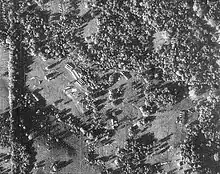
ကိုရိုနာဂြိုဟ်တုနှင့်ယူ-၂လေယာဉ်များက ဒုံးပျံများတွေ့ရှိခြင်း
Despite the increasing evidence of a military build-up on Cuba, no U-2 flights were made over Cuba from September 5 until October 14. The first problem that caused the pause in reconnaissance flights took place on August 30, an Air Force Strategic Air Command (SAC) U-2 flew over Sakhalin Island in the Far East by mistake. The Soviets lodged a protest and the US apologized. Nine days later, a Taiwanese-operated U-2[26][27] was lost over western China, probably to a SAM. US officials were worried that one of the Cuban or Soviet SAMs in Cuba might shoot down a CIA U-2, initiating another international incident. Therefore, the Kennedy administration decided to try the new Corona (satellite) KH series in an attempt to obtain sufficient evidence. Preparations for an emergency launch proceeded at fever pitch and led to the NRO's institution of "R7" status, that is, keeping a Corona spy satellite ready for launch on 7 days' notice in case of an emergency. At the end of September, Navy reconnaissance aircraft photographed the Soviet ship Kasimov with large crates on its deck the size and shape of Il-28 light bombers.[12]
With evidence in hand from both the Corona satellite and Navy Reconnaissance aircraft, at the beginning of October the administration decided it was now worth risking U-2 flights over Cuba. They decided to transfer the Cuban U-2 reconnaissance missions to the Air Force; if another U-2 was shot down, they thought a cover story involving Air Force flights would be easier to explain than CIA flights. There was also some evidence that the Department of Defense and the Air Force lobbied to get responsibility for the Cuban flights.[12] When the reconnaissance missions were re-authorized on October 8, weather kept the planes from flying. The US first obtained U-2 photographic evidence of the missiles on October 14, when a U-2 flight piloted by Major Richard Heyser took 928 pictures, capturing images of what turned out to be an SS-4 construction site at San Cristóbal, Pinar del Río Province, in western Cuba.[28]
အမေရိကန်သမ္မတကကြေငြာခြင်း
On October 15, the CIA's National Photographic Interpretation Center reviewed the U-2 photographs and identified objects that they interpreted as medium range ballistic missiles. That evening, the CIA notified the Department of State and at 8:30 pm EDT, National Security Adviser McGeorge Bundy elected to wait until morning to tell the President. Secretary of Defense Robert McNamara was briefed at midnight. The next morning, Bundy met with Kennedy and showed him the U-2 photographs and briefed him on the CIA's analysis of the images.[29] At 6:30 pm EDT, Kennedy convened a meeting of the nine members of the National Security Council and five other key advisers,[30] in a group he formally named the Executive Committee of the National Security Council (EXCOMM) after the fact on October 22 by the National Security Action Memorandum 196.[31]
Responses considered
The US had no plan in place because US intelligence had been convinced that the Soviets would never install nuclear missiles in Cuba. The EXCOMM quickly discussed several possible courses of action, including:[19][32]
- Do nothing: American vulnerability to Soviet missiles was not new. Newly placed missiles in Cuba made little strategic difference in the military balance of power.
- Diplomacy: Use diplomatic pressure to get the Soviet Union to remove the missiles.
- Warning: Send a message to Castro to warn him of the grave danger he, and Cuba were in.
- Blockade: Use the US Navy to block any missiles from arriving in Cuba.
- Air strike: Use the US Air Force to attack all known missile sites.
- Invasion: Full force invasion of Cuba and overthrow of Castro.
The Joint Chiefs of Staff unanimously agreed that a full-scale attack and invasion was the only solution. They believed that the Soviets would not attempt to stop the US from conquering Cuba. Kennedy was skeptical.
တမ်းပလိတ်:Block quote
Kennedy concluded that attacking Cuba by air would signal the Soviets to presume "a clear line" to conquer Berlin. Kennedy also believed that United States' allies would think of the US as "trigger-happy cowboys" who lost Berlin because they could not peacefully resolve the Cuban situation.[1]:332
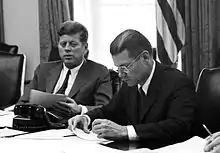
The EXCOMM then discussed the effect on the strategic balance of power, both political and military. The Joint Chiefs of Staff believed that the missiles would seriously alter the military balance, but Secretary of Defense Robert McNamara disagreed. He was convinced that the missiles would not affect the strategic balance at all. An extra forty, he reasoned, would make little difference to the overall strategic balance. The US already had approximately 5,000 strategic warheads,[33]:261 while the Soviet Union had only 300. He concluded that the Soviets having 340 would not therefore substantially alter the strategic balance. In 1990, he reiterated that "it made no difference...The military balance wasn't changed. I didn't believe it then, and I don't believe it now."[34]
The EXCOMM agreed that the missiles would affect the political balance. First, Kennedy had explicitly promised the American people less than a month before the crisis that "if Cuba should possess a capacity to carry out offensive actions against the United States...the United States would act."[35]:674–681 Second, US credibility among their allies, and among the American people, would be damaged if they allowed the Soviet Union to appear to redress the strategic balance by placing missiles in Cuba. Kennedy explained after the crisis that "it would have politically changed the balance of power. It would have appeared to, and appearances contribute to reality."[36]
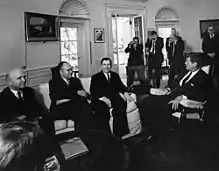
၁၉၆၂၊ အောက်တိုဘာ၁၈တွင် ဒုံးပျံများသည် ကာကွယ်ရေးသက်သက်အတွက်သာဟုဆိုသူ ဆိုဗီယက်နိုင်ငံခြားရေးဝန်ကြီး အန်ဒရေးဂရိုမီကိုအား သမ္မတကနေဒီက ဘဲဥပုံရုံးခန်းတွင်တွေ့ဆုံခြင်းခဲ့သည်။ Not wanting to expose what he already knew, and wanting to avoid panicking the American public,[37] the President did not reveal that he was already aware of the missile build-up.[38]
အောက်တိုဘာ ၁၉တွင် ယူ-၂သူလျှိုလေယာဉ်များသည် အလုပ်ခွင် ၄ခုကိုတွေ့ရှိပြသနိုင်ခဲ့သည်။ As part of the blockade, the US military was put on high alert to enforce the blockade and to be ready to invade Cuba at a moment's notice. The 1st Armored Division was sent to Georgia, and five army divisions were alerted for combat operations. The Strategic Air Command (SAC) distributed its shorter-ranged B-47 Stratojet medium bombers to civilian airports and sent aloft its B-52 Stratofortress heavy bombers.[39]
Operational Plans
Two Operational Plans (OPLAN) were considered. OPLAN 316 envisioned a full invasion of Cuba by Army and Marine units supported by the Navy following Air Force and naval airstrikes. However, Army units in the United States would have had trouble fielding mechanized and logistical assets, while the US Navy could not supply sufficient amphibious shipping to transport even a modest armored contingent from the Army. OPLAN 312, primarily an Air Force and Navy carrier operation, was designed with enough flexibility to do anything from engaging individual missile sites to providing air support for OPLAN 316's ground forces.[40]
ပိတ်ဆို့ခြင်း("Quarantine")
 |
Address on the Buildup of Arms in Cuba
Kennedy addressing the nation on October 22, 1962 about the buildup of arms on Cuba |
| Problems playing this file? See media help. | |
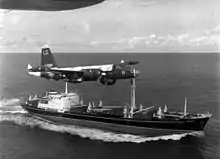
Kennedy met with members of EXCOMM and other top advisers throughout October 21, considering two remaining options: an air strike primarily against the Cuban missile bases, or a naval blockade of Cuba.[38] A full-scale invasion was not the administration's first option. Robert McNamara supported the naval blockade as a strong but limited military action that left the US in control. However, the term "blockade" was problematic. According to international law a blockade is an act of war, but the Kennedy administration did not think that the USSR would be provoked to attack by a mere blockade.[42] Additionally, legal experts at the State Department and Justice Department concluded that a declaration of war could be avoided so long as another legal justification, based on the Rio Treaty for defense of the Western Hemisphere, was obtained via a resolution by a two-thirds vote from the members or the Organization of American States (OAS).[43]
Admiral Anderson, Chief of Naval Operations wrote a position paper that helped Kennedy to differentiate between what they termed a "quarantine"[4] of offensive weapons and a blockade of all materials, claiming that a classic blockade was not the original intention. Since it would take place in international waters, Kennedy obtained the approval of the OAS for military action under the hemispheric defense provisions of the Rio Treaty.
တမ်းပလိတ်:Block quote
တမ်းပလိတ်:Block quote
On October 19, the EXCOMM formed separate working groups to examine the air strike and blockade options, and by the afternoon most support in the EXCOMM shifted to the blockade option. Reservations about the plan continued to be voiced as late as the twenty-first, however, the paramount one being that once the blockade was put into effect, the Soviets would rush to complete some of the missiles. Consequently, the United States could find itself bombing operational missiles were the blockade to fail to force Khrushchev to remove the missiles already on the island.[44]
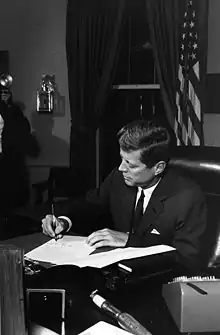
At 3:00 pm EDT on October 22, President Kennedy formally established the Executive Committee (EXCOMM) with National Security Action Memorandum (NSAM) 196. At 5:00 pm, he met with Congressional leaders who contentiously opposed a blockade and demanded a stronger response. In Moscow, Ambassador Kohler briefed Chairman Khrushchev on the pending blockade and Kennedy's speech to the nation. Ambassadors around the world gave advance notice to non-Eastern Bloc leaders. Before the speech, US delegations met with Canadian Prime Minister John Diefenbaker, British Prime Minister Harold Macmillan, West German Chancellor Konrad Adenauer, and French President Charles de Gaulle to brief them on the US intelligence and their proposed response. All were supportive of the US position.[45]
On October 22 at 7:00 pm EDT, President Kennedy delivered a nation-wide televised address on all of the major networks announcing the discovery of the missiles.
တမ်းပလိတ်:Block quote
Kennedy described the administration's plan:
တမ်းပလိတ်:Block quote
During the speech a directive went out to all US forces worldwide placing them on DEFCON 3. The heavy cruiser USS Newport News was designated flagship for the blockade,[4] with the USS Leary (DD-879) as Newport News' destroyer escort.[46]
Crisis deepens
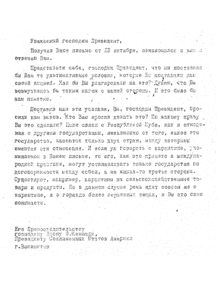
On October 23 at 11:24 am EDT a cable drafted by George Ball to the US Ambassador in Turkey and the US Ambassador to NATO notified them that they were considering making an offer to withdraw what the US knew to be nearly obsolete missiles from Italy and Turkey in exchange for the Soviet withdrawal from Cuba. Turkish officials replied that they would "deeply resent" any trade for the US missile's presence in their country.[47] Two days later, on the morning of October 25, journalist Walter Lippmann proposed the same thing in his syndicated column. Castro reaffirmed Cuba's right to self-defense and said that all of its weapons were defensive and Cuba would not allow an inspection.[8]
နိုင်ငံတကာတုံ့ပြန်မှုများ
Three days after Kennedy's speech, the Chinese People's Daily announced that "650,000,000 Chinese men and women were standing by the Cuban people".[45] In West Germany, newspapers supported the United States' response, contrasting it with the weak American actions in the region during the preceding months. They also expressed some fear that the Soviets might retaliate in Berlin. In France on October 23, the crisis made the front page of all the daily newspapers. The next day, an editorial in Le Monde expressed doubt about the authenticity of the CIA's photographic evidence. Two days later, after a visit by a high-ranking CIA agent, they accepted the validity of the photographs. Also in France, in the October 29 issue of Le Figaro, Raymond Aron wrote in support of the American response.[48]
ဆိုဗီယက်ကြေငြာချက်
At the time, the crisis continued unabated, and on the evening of October 24, the Soviet news agency TASS broadcast a telegram from Khrushchev to President Kennedy, in which Khrushchev warned that the United States' "pirate action" would lead to war. However, this was followed at 9:24 pm by a telegram from Khrushchev to Kennedy which was received at 10:52 pm EDT, in which Khrushchev stated, "If you coolly weigh the situation which has developed, not giving way to passions, you will understand that the Soviet Union cannot fail to reject the arbitrary demands of the United States" and that the Soviet Union views the blockade as "an act of aggression" and their ships will be instructed to ignore it.
အမေရိကန်တို့တပ်လှန်မှုအဆင့်မြှင့်ခြင်း
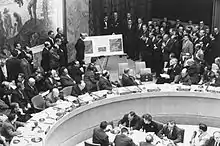
The United States requested an emergency meeting of the United Nations Security Council on October 25. US Ambassador to the United Nations Adlai Stevenson confronted Soviet Ambassador Valerian Zorin in an emergency meeting of the SC challenging him to admit the existence of the missiles. Ambassador Zorin refused to answer. The next day at 10:00 pm EDT, the United States raised the readiness level of SAC forces to DEFCON 2. For the only confirmed time in US history, while the B-52 bombers went on continuous airborne alert, the B-47 medium bombers were dispersed to various military and civilian airfields, and made ready to take off, fully equipped, on 15 minutes' notice.[49][50] One-eighth of SAC's 1,436 bombers were on airborne alert, some 145 intercontinental ballistic missiles stood on ready alert, while Air Defense Command (ADC) redeployed 161 nuclear-armed interceptors to 16 dispersal fields within nine hours with one-third maintaining 15-minute alert status.[40] Twenty-three nuclear-armed B-52 were sent to orbit points within striking distance of the Soviet Union so that the latter might observe that the US was serious.[51] Jack J. Catton later estimated that about 80% of SAC's planes were ready for launch during the crisis; David A. Burchinal recalled that, by contrast,[52]
the Russians were so thoroughly stood down, and we knew it. They didn't make any move. They did not increase their alert; they did not increase any flights, or their air defense posture. They didn't do a thing, they froze in place. We were never further from nuclear war than at the time of Cuba, never further.[52]
"By October 22, Tactical Air Command (TAC) had 511 fighters plus supporting tankers and reconnaissance aircraft deployed to face Cuba on one-hour alert status. However, TAC and the Military Air Transport Service had problems. The concentration of aircraft in Florida strained command and support echelons; which faced critical undermanning in security, armaments, and communications; the absence of initial authorization for war-reserve stocks of conventional munitions forced TAC to scrounge; and the lack of airlift assets to support a major airborne drop necessitated the call-up of 24 Reserve squadrons."[40]
On October 25 at 1:45 am EDT, Kennedy responded to Khrushchev's telegram, stating that the United States was forced into action after receiving repeated assurances that no offensive missiles were being placed in Cuba, and that when these assurances proved to be false, the deployment "required the responses I have announced... I hope that your government will take necessary action to permit a restoration of the earlier situation."
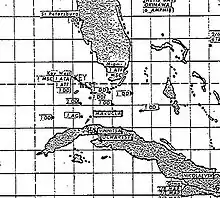
Blockade challenged
At 7:15 am EDT on October 25, the USS Essex and USS Gearing attempted to intercept the Bucharest but failed to do so. Fairly certain the tanker did not contain any military material, they allowed it through the blockade. Later that day, at 5:43 pm, the commander of the blockade effort ordered the USS Joseph P. Kennedy, Jr to intercept and board the Lebanese freighter Marucla. This took place the next day, and the Marucla was cleared through the blockade after its cargo was checked.[53]
At 5:00 pm EDT on October 25, William Clements announced that the missiles in Cuba were still actively being worked on. This report was later verified by a CIA report that suggested there had been no slow-down at all. In response, Kennedy issued Security Action Memorandum 199, authorizing the loading of nuclear weapons onto aircraft under the command of SACEUR (which had the duty of carrying out first air strikes on the Soviet Union). During the day, the Soviets responded to the blockade by turning back 14 ships presumably carrying offensive weapons.[50]
Crisis stalemated
The next morning, October 26, Kennedy informed the EXCOMM that he believed only an invasion would remove the missiles from Cuba. However, he was persuaded to give the matter time and continue with both military and diplomatic pressure. He agreed and ordered the low-level flights over the island to be increased from two per day to once every two hours. He also ordered a crash program to institute a new civil government in Cuba if an invasion went ahead.
At this point, the crisis was ostensibly at a stalemate. The USSR had shown no indication that they would back down and had made several comments to the contrary. The US had no reason to believe otherwise and was in the early stages of preparing for an invasion, along with a nuclear strike on the Soviet Union in case it responded militarily, which was assumed.[54]
Secret negotiations
At 1:00 pm EDT on October 26, John A. Scali of ABC News had lunch with Aleksandr Fomin (alias of spy Alexander Feklisov) at Fomin's request. Fomin noted, "War seems about to break out" and asked Scali to use his contacts to talk to his "high-level friends" at the State Department to see if the US would be interested in a diplomatic solution. He suggested that the language of the deal would contain an assurance from the Soviet Union to remove the weapons under UN supervision and that Castro would publicly announce that he would not accept such weapons in the future, in exchange for a public statement by the US that it would never invade Cuba.[55] The US responded by asking the Brazilian government to pass a message to Castro that the US would be "unlikely to invade" if the missiles were removed.[47]
Mr. President, we and you ought not now to pull on the ends of the rope in which you have tied the knot of war, because the more the two of us pull, the tighter that knot will be tied. And a moment may come when that knot will be tied so tight that even he who tied it will not have the strength to untie it, and then it will be necessary to cut that knot, and what that would mean is not for me to explain to you, because you yourself understand perfectly of what terrible forces our countries dispose.
Consequently, if there is no intention to tighten that knot and thereby to doom the world to the catastrophe of thermonuclear war, then let us not only relax the forces pulling on the ends of the rope, let us take measures to untie that knot. We are ready for this.
On October 26 at 6:00 pm EDT, the State Department started receiving a message that appeared to be written personally by Khrushchev. It was Saturday at 2:00 am in Moscow. The long letter took several minutes to arrive, and it took translators additional time to translate and transcribe it.[47]
Robert Kennedy described the letter as "very long and emotional". Khrushchev reiterated the basic outline that had been stated to John Scali earlier in the day, "I propose: we, for our part, will declare that our ships bound for Cuba are not carrying any armaments. You will declare that the United States will not invade Cuba with its troops and will not support any other forces which might intend to invade Cuba. Then the necessity of the presence of our military specialists in Cuba will disappear." At 6:45 pm EDT, news of Fomin's offer to Scali was finally heard and was interpreted as a "set up" for the arrival of Khrushchev's letter. The letter was then considered official and accurate, although it was later learned that Fomin was almost certainly operating of his own accord without official backing. Additional study of the letter was ordered and continued into the night.[47]
အရေးအခင်းဆက်လက်ဖြစ်ပွားခြင်း
တမ်းပလိတ်:Block quote
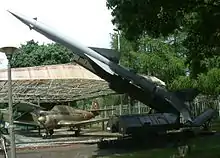
Castro, on the other hand, was convinced that an invasion of Cuba was soon at hand, and on October 26, he sent a telegram to Khrushchev that appeared to call for a pre-emptive nuclear strike on the USA. However, in a 2010 interview, Castro said of his recommendation for the Soviets to attack America before they made any move against Cuba: "After I've seen what I've seen, and knowing what I know now, it wasn't worth it at all."[57] Castro also ordered all anti-aircraft weapons in Cuba to fire on any US aircraft,[58] whereas in the past they had been ordered only to fire on groups of two or more. At 6:00 am EDT on October 27, the CIA delivered a memo reporting that three of the four missile sites at San Cristobal and the two sites at Sagua la Grande appeared to be fully operational. They also noted that the Cuban military continued to organize for action, although they were under order not to initiate action unless attacked.
At 9:00 am EDT on October 27, Radio Moscow began broadcasting a message from Khrushchev. Contrary to the letter of the night before, the message offered a new trade, that the missiles on Cuba would be removed in exchange for the removal of the Jupiter missiles from Italy and Turkey. At 10:00 am EDT, the executive committee met again to discuss the situation and came to the conclusion that the change in the message was due to internal debate between Khrushchev and other party officials in the Kremlin.[59]:300 McNamara noted that another tanker, the Grozny, was about ၆၀၀ မိုင် (၉၇၀ ကီလိုမီတာ) out and should be intercepted. He also noted that they had not made the USSR aware of the blockade line and suggested relaying this information to them via U Thant at the United Nations.[60]
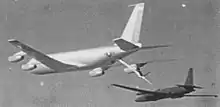
While the meeting progressed, at 11:03 am EDT a new message began to arrive from Khrushchev. The message stated, in part,
တမ်းပလိတ်:Block quote
The executive committee continued to meet through the day.
Throughout the crisis, Turkey had repeatedly stated that it would be upset if the Jupiter missiles were removed. Italy's Prime Minister Fanfani, who was also Foreign Minister ad interim, offered to allow withdrawal of the missiles deployed in Apulia as a bargaining chip. He gave the message to one of his most trusted friends, Ettore Bernabei, the general manager of RAI-TV, to convey to Arthur M. Schlesinger, Jr.. Bernabei was in New York to attend an international conference on satellite TV broadcasting. Unknown to the Soviets, the US regarded the Jupiter missiles as obsolete and already supplanted by the Polaris nuclear ballistic submarine missiles.[12]
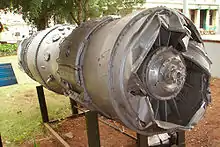
On the morning of October 27, a U-2F (the third CIA U-2A, modified for air-to-air refueling) piloted by USAF Major Rudolf Anderson,[61] departed its forward operating location at McCoy AFB, Florida. At approximately 12:00 pm EDT, the aircraft was struck by a S-75 Dvina (NATO designation SA-2 Guideline) SAM missile launched from Cuba. The aircraft was shot down and Anderson was killed. The stress in negotiations between the USSR and the US intensified, and only much later was it learned that the decision to fire the missile was made locally by an undetermined Soviet commander acting on his own authority. Later that day, at about 3:41 pm EDT, several US Navy RF-8A Crusader aircraft on low-level photoreconnaissance missions were fired upon, and one was hit by a 37 mm shell but managed to return to base.
At 4:00 pm EDT, Kennedy recalled members of EXCOMM to the White House and ordered that a message immediately be sent to U Thant asking the Soviets to "suspend" work on the missiles while negotiations were carried out. During this meeting, General Maxwell Taylor delivered the news that the U-2 had been shot down. Kennedy had earlier claimed he would order an attack on such sites if fired upon, but he decided to not act unless another attack was made. In an interview 40 years later, McNamara said:
တမ်းပလိတ်:Block quote
Drafting the response
Emissaries sent by both Kennedy and Nikita Khrushchev agreed to meet at the Yenching Palace Chinese restaurant in the Cleveland Park neighborhood of Washington D.C. on the evening of October 27.[62] Kennedy suggested that they take Khrushchev's offer to trade away the missiles. Unknown to most members of the EXCOMM, Robert Kennedy had been meeting with the Soviet Ambassador in Washington to discover whether these intentions were genuine. The EXCOMM was generally against the proposal because it would undermine NATO's authority, and the Turkish government had repeatedly stated it was against any such trade.
As the meeting progressed, a new plan emerged and Kennedy was slowly persuaded. The new plan called for the President to ignore the latest message and instead to return to Khrushchev's earlier one. Kennedy was initially hesitant, feeling that Khrushchev would no longer accept the deal because a new one had been offered, but Llewellyn Thompson argued that he might accept it anyway.[63] White House Special Counsel and Adviser Ted Sorensen and Robert Kennedy left the meeting and returned 45 minutes later with a draft letter to this effect. The President made several changes, had it typed, and sent it.
After the EXCOMM meeting, a smaller meeting continued in the Oval Office. The group argued that the letter should be underscored with an oral message to Ambassador Dobrynin stating that if the missiles were not withdrawn, military action would be used to remove them. Dean Rusk added one proviso, that no part of the language of the deal would mention Turkey, but there would be an understanding that the missiles would be removed "voluntarily" in the immediate aftermath. The President agreed, and the message was sent.
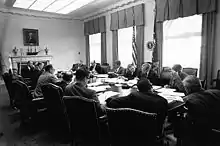
At Juan Britoတမ်းပလိတ်:Specify's request, Fomin and Scali met again. Scali asked why the two letters from Khrushchev were so different, and Fomin claimed it was because of "poor communications". Scali replied that the claim was not credible and shouted that he thought it was a "stinking double cross". He went on to claim that an invasion was only hours away, at which point Fomin stated that a response to the US message was expected from Khrushchev shortly, and he urged Scali to tell the State Department that no treachery was intended. Scali said that he did not think anyone would believe him, but he agreed to deliver the message. The two went their separate ways, and Scali immediately typed out a memo for the EXCOMM.
Within the US establishment, it was well understood that ignoring the second offer and returning to the first put Khrushchev in a terrible position. Military preparations continued, and all active duty Air Force personnel were recalled to their bases for possible action. Robert Kennedy later recalled the mood, "We had not abandoned all hope, but what hope there was now rested with Khrushchev's revising his course within the next few hours. It was a hope, not an expectation. The expectation was military confrontation by Tuesday, and possibly tomorrow...".
At 8:05 pm EDT, the letter drafted earlier in the day was delivered. The message read, "As I read your letter, the key elements of your proposals—which seem generally acceptable as I understand them—are as follows: 1) You would agree to remove these weapons systems from Cuba under appropriate United Nations observation and supervision; and undertake, with suitable safe-guards, to halt the further introduction of such weapon systems into Cuba. 2) We, on our part, would agree—upon the establishment of adequate arrangements through the United Nations, to ensure the carrying out and continuation of these commitments (a) to remove promptly the quarantine measures now in effect and (b) to give assurances against the invasion of Cuba." The letter was also released directly to the press to ensure it could not be "delayed".
With the letter delivered, a deal was on the table. However, as Robert Kennedy noted, there was little expectation it would be accepted. At 9:00 pm EDT, the EXCOMM met again to review the actions for the following day. Plans were drawn up for air strikes on the missile sites as well as other economic targets, notably petroleum storage. McNamara stated that they had to "have two things ready: a government for Cuba, because we're going to need one; and secondly, plans for how to respond to the Soviet Union in Europe, because sure as hell they're going to do something there".
At 12:12 am EDT, on October 27, the US informed its NATO allies that "the situation is growing shorter... the United States may find it necessary within a very short time in its interest and that of its fellow nations in the Western Hemisphere to take whatever military action may be necessary." To add to the concern, at 6 am the CIA reported that all missiles in Cuba were ready for action.
Later on that same day, what the White House later called "Black Saturday", the US Navy dropped a series of "signaling depth charges" (practice depth charges the size of hand grenades[64]) on a Soviet submarine (B-59) at the blockade line, unaware that it was armed with a nuclear-tipped torpedo with orders that allowed it to be used if the submarine was "hulled" (a hole in the hull from depth charges or surface fire).[65] The decision to launch these required agreement from all three officers on board, but one of them, Vasili Arkhipov, objected and so the launch was narrowly averted.
On the same day a US U-2 spy plane made an accidental, unauthorized ninety-minute overflight of the Soviet Union's far eastern coast.[66] The Soviets responded by scrambling MiG fighters from Wrangel Island; in turn the Americans launched F-102 fighters armed with nuclear air-to-air missiles over the Bering Sea.[67]
On October 27, Khrushchev also received a letter from Castro – what is now known as the Armageddon Letter (dated Oct. 26) – interpreted as urging the use of nuclear force in the event of an attack on Cuba.[68] "I believe the imperialists' aggressiveness is extremely dangerous and if they actually carry out the brutal act of invading Cuba in violation of international law and morality, that would be the moment to eliminate such danger forever through an act of clear legitimate defense, however harsh and terrible the solution would be," Castro wrote.[69]
အရေးအခင်းအဆုံးသတ်ခြင်း
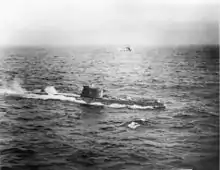
On October 27, after much deliberation between the Soviet Union and Kennedy's cabinet, Kennedy secretly agreed to remove all missiles set in southern Italy and in Turkey, the latter on the border of the Soviet Union, in exchange for Khrushchev removing all missiles in Cuba.[70]
At 9:00 am EDT, on October 28, a new message from Khrushchev was broadcast on Radio Moscow. Khrushchev stated that, "the Soviet government, in addition to previously issued instructions on the cessation of further work at the building sites for the weapons, has issued a new order on the dismantling of the weapons which you describe as 'offensive' and their crating and return to the Soviet Union."
Kennedy immediately responded, issuing a statement calling the letter "an important and constructive contribution to peace". He continued this with a formal letter:
I consider my letter to you of October twenty-seventh and your reply of today as firm undertakings on the part of both our governments which should be promptly carried out... The US will make a statement in the framework of the Security Council in reference to Cuba as follows: it will declare that the United States of America will respect the inviolability of Cuban borders, its sovereignty, that it take the pledge not to interfere in internal affairs, not to intrude themselves and not to permit our territory to be used as a bridgehead for the invasion of Cuba, and will restrain those who would plan to carry an aggression against Cuba, either from US territory or from the territory of other countries neighboring to Cuba.[71]:103
Kennedy's planned statement would also contain suggestions he had received from his adviser, Arthur M. Schlesinger, Jr., in a "Memorandum for the President" describing the "Post Mortem on Cuba."[72]
The US continued the blockade, and in the following days, aerial reconnaissance proved that the Soviets were making progress in removing the missile systems. The 42 missiles and their support equipment were loaded onto eight Soviet ships. The ships left Cuba from November 5–9. The US made a final visual check as each of the ships passed the blockade line. Further diplomatic efforts were required to remove the Soviet IL-28 bombers, and they were loaded on three Soviet ships on December 5 and 6. Concurrent with the Soviet commitment on the IL-28's, the US Government announced the end of the blockade effective at 6:45 pm EDT on November 20, 1962.[39]
At the time when the Kennedy administration thought that the Cuban Missile Crisis was resolved, nuclear tactical rockets stayed in Cuba since they were not part of the Kennedy-Khrushchev understandings. However, the Soviets changed their minds, fearing possible future Cuban militant steps, and at November 22, 1962 the Soviet Deputy Prime Minister Anastas Mikoyan told Castro that those rockets with the nuclear warheads, were being removed too.[17]
In his negotiations with the Soviet Ambassador Anatoly Dobrynin, US Attorney General Robert Kennedy informally proposed that the Jupiter missiles in Turkey would be removed "within a short time after this crisis was over."[73]:222 The last US missiles were disassembled by April 24, 1963, and were flown out of Turkey soon after.[74]
The practical effect of this Kennedy-Khrushchev Pact was that it effectively strengthened Castro's position in Cuba, guaranteeing that the US would not invade Cuba. It is possible that Khrushchev only placed the missiles in Cuba to get Kennedy to remove the missiles from Italy and Turkey and that the Soviets had no intention of resorting to nuclear war if they were out-gunned by the Americans.[75] Because the withdrawal of the Jupiter missiles from NATO bases in Southern Italy and Turkey was not made public at the time, Khrushchev appeared to have lost the conflict and become weakened. The perception was that Kennedy had won the contest between the superpowers and Khrushchev had been humiliated. This is not entirely the case as both Kennedy and Khrushchev took every step to avoid full conflict despite the pressures of their governments. Khrushchev held power for another two years.[71]:102–105
Aftermath
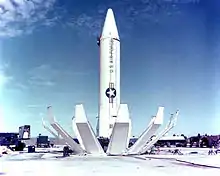
The compromise embarrassed Khrushchev and the Soviet Union because the withdrawal of US missiles from Italy and Turkey was a secret deal between Kennedy and Khrushchev. The Soviets were seen as retreating from circumstances that they had started. Khrushchev's fall from power two years later was in part because of the Politburo embarrassment at both Khrushchev's eventual concessions to the US and his ineptitude in precipitating the crisis in the first place. According to Dobrynin, the top Soviet leadership took the Cuban outcome as "a blow to its prestige bordering on humiliation".[76]
Cuba perceived the outcome as a partial betrayal by the Soviets, given that decisions on how to resolve the crisis had been made exclusively by Kennedy and Khrushchev. Castro was especially upset that certain issues of interest to Cuba, such as the status of the US Naval Base in Guantánamo, were not addressed. This caused Cuban-Soviet relations to deteriorate for years to come.[77]:278 On the other hand, Cuba continued to be protected from invasion.
Although General Curtis LeMay told the President that he considered the resolution of the Cuban missile crisis the "greatest defeat in our history", his was a minority position.[1]:335 He had pressed for an immediate invasion of Cuba as soon as the crisis began, and still favored invading Cuba even after the Soviets had withdrawn their missiles.[78] 25 years later, LeMay still believed that "We could have gotten not only the missiles out of Cuba, we could have gotten the Communists out of Cuba at that time".[52]
After the crisis the United States and the Soviet Union created the Moscow–Washington hotline, a direct communications link between Moscow and Washington, D.C. The purpose was to have a way that the leaders of the two Cold War countries could communicate directly to solve such a crisis. The world-wide US Forces DEFCON 3 status was returned to DEFCON 4 on November 20, 1962. U-2 pilot Major Anderson's body was returned to the United States and he was buried with full military honors in South Carolina. He was the first recipient of the newly created Air Force Cross, which was awarded posthumously.
Although Anderson was the only combatant fatality during the crisis, 11 crew members of three reconnaissance Boeing RB-47 Stratojets of the 55th Strategic Reconnaissance Wing were also killed in crashes during the period between September 27 and November 11, 1962.[79] Further, seven crew died when a MATS Boeing C-135B Stratolifter delivering ammunition to Guantanamo Bay Naval Base stalled and crashed on approach on October 23.[80]
Critics including Seymour Melman[81] and Seymour Hersh[82] suggested that the Cuban missile crisis encouraged US use of military means, such as in the Vietnam War. This Soviet-American confrontation was synchronous with the Sino-Indian War, dating from the US's military blockade of Cuba; historians speculate that the Chinese attack against India for disputed land was meant to coincide with the Cuban missile crisis.[83]
Post-Crisis Revelations
Arthur M. Schlesinger, Jr., a historian and adviser to John F. Kennedy, told National Public Radio in an interview on October 16, 2002 that Castro did not want the missiles, but that Khrushchev had pressured Castro to accept them. Castro was not completely happy with the idea but the Cuban National Directorate of the Revolution accepted them to protect Cuba against US attack, and to aid its ally, the Soviet Union.[77]:272 Schlesinger believed that when the missiles were withdrawn, Castro was angrier with Khrushchev than he was with Kennedy because Khrushchev had not consulted Castro before deciding to remove them.[note 1]
In early 1992, it was confirmed that Soviet forces in Cuba had, by the time the crisis broke, received tactical nuclear warheads for their artillery rockets and Il-28 bombers.[84] Castro stated that he would have recommended their use if the US invaded despite knowing Cuba would be destroyed.[84]
Arguably the most dangerous moment in the crisis was only recognized during the Cuban Missile Crisis Havana conference in October 2002. Attended by many of the veterans of the crisis, they all learned that on October 26, 1962 the USS Beale had tracked and dropped signaling depth charges (the size of hand grenades) on the B-59, a Soviet Project 641 (NATO designation Foxtrot) submarine which, unknown to the US, was armed with a 15 kiloton nuclear torpedo. Running out of air, the Soviet submarine was surrounded by American warships and desperately needed to surface. An argument broke out among three officers on the B-59, including submarine captain Valentin Savitsky, political officer Ivan Semonovich Maslennikov, and Deputy brigade commander Captain 2nd rank (US Navy Commander rank equivalent) Vasili Arkhipov. An exhausted Savitsky became furious and ordered that the nuclear torpedo on board be made combat ready. Accounts differ about whether Commander Arkhipov convinced Savitsky not to make the attack, or whether Savitsky himself finally concluded that the only reasonable choice left open to him was to come to the surface.[85]:303, 317 During the conference Robert McNamara stated that nuclear war had come much closer than people had thought. Thomas Blanton, director of the National Security Archive, said, "A guy called Vasili Arkhipov saved the world."
Fifty years after the crisis, Graham Allison wrote:
Fifty years ago, the Cuban missile crisis brought the world to the brink of nuclear disaster. During the standoff, U.S. President John F. Kennedy thought the chance of escalation to war was "between 1 in 3 and even," and what we have learned in later decades has done nothing to lengthen those odds. We now know, for example, that in addition to nuclear-armed ballistic missiles, the Soviet Union had deployed 100 tactical nuclear weapons to Cuba, and the local Soviet commander there could have launched these weapons without additional codes or commands from Moscow. The U.S. air strike and invasion that were scheduled for the third week of the confrontation would likely have triggered a nuclear response against American ships and troops, and perhaps even Miami. The resulting war might have led to the deaths of 100 million Americans and over 100 million Russians.[86][87]
BBC journalist Joe Matthews published on October 13, 2012 the story behind the 100 tactical nuclear warheads mentioned by Graham Allison in the excerpt above.[88] Khrushchev feared that Castro's hurt pride and widespread Cuban indignation over the concessions he had made to Kennedy might lead to a breakdown of the agreement between the Soviet Union and the United States. In order to prevent this Khrushchev decided to make Cuba a special offer. The offer was to give Cuba more than 100 tactical nuclear weapons that had been shipped to Cuba along with the long-range missiles, but which crucially had passed completely under the radar of US intelligence. Khrushchev concluded that because the Americans hadn't listed the missiles on their list of demands, the Soviet Union's interests would be well served by keeping them in Cuba.[88]
Anastas Mikoyan was tasked with the negotiations with Castro over the missile transfer deal designed to prevent a breakdown in the relations between Cuba and the Soviet Union. While in Havana, Mikoyan witnessed the mood swings and paranoia of Castro, who was convinced that Moscow had done the deal with the United States at the expense of Cuba's defence. Mikoyan, on his own initiative, decided that Castro and his military not be given control of weapons with an explosive force equal to 100 Hiroshima-sized bombs under any circumstances. He defused the seemingly intractable situation, which risked re-escalating the crisis, on November 22, 1962. During a tense, four-hour meeting, Mikoyan convinced Castro that despite Moscow's desire to help, it would be in breach of an unpublished Soviet law (which didn't actually exist) to transfer the missiles permanently into Cuban hands and provide them with an independent nuclear deterrent. Castro was forced to give way and - much to the relief of Khrushchev and the whole Soviet government - the tactical nuclear weapons were crated and returned by sea to the Soviet Union during December 1962.[88]
See also
- Bomber gap
- Cuba–Soviet Union relations
- Dino Brugioni
- International crisis
- Norwegian rocket incident
- Nuclear disarmament
- Stanislav Petrov
- Vogelsang, Zehdenick, an earlier installation outside the Soviet Union of R-5 missiles in East Germany, three years before the Cuban missile crisis
Media
(Listed chronologically)
- Thirteen Days, Robert F. Kennedy's account of the crisis, released in 1969
- The Missiles of October, 1974 TV docudrama about the crisis
- The World Next Door, 1990 novel by Brad Ferguson, set in this period
- Quantum Leap,1991 TV Show, (Season 3 Episode, Nuclear Family - October 26, 1962), Sam must deal with the panic associated with the Cuban missile crisis as a Florida fallout shelter salesman.
- Matinee, 1993 film set in Key West, Florida during the Cuban Missile Crisis
- ရုပ်ရှင်ဇတ်လမ်းတိုအား Symposium on Intelligence and the Cuban Missile Crisis 1962 Internet Archive တွင် အခမဲ့ ဒေါင်းလုတ်ဆွဲနိုင်သည်။
- seaQuest 2032, 1995 TV Show, (Season 3 Episode, "Second Chance"), seaQuest inadvertently travels back to 1962 where their presence accidentally interferes with the Cuban missile crisis
- Blast from the Past (film), 1999 American romantic comedy film, set in this period
- Resurrection Day, 1999 alternate history novel written by Brendan DuBois, set in this period
- Thirteen Days (film), 2000 docudrama directed by Roger Donaldson about the crisis
- The Fog of War, 2003 American documentary film about the life and times of former US Secretary of Defense Robert S. McNamara directed by Errol Morris, which won that years' Academy Award for Best Documentary Feature.
- Metal Gear Solid 3: Snake Eater, 2004 video game directed by Hideo Kojima, features a fictional conflict inspired by the Cuban missile crisis
- "Meditations in an Emergency", the last episode of season 2 of the television series Mad Men takes place during the crisis
- Call of Duty: Black Ops, 2010 video game, set during and after the Cuban missile crisis.
- The Kennedys (TV miniseries), 2011 production chronicling the lives of the Kennedy family, including a dramatization of the crisis
- X-Men: First Class, 2011 superhero film set during the Cuban missile crisis
- The Armageddon Letters, a transmedia storytelling of the crisis with animated short films and other digital content
- "Cuban Missile Crisis: The Man Who Saved the World", Secrets of the Dead, PBS TV documentary, October 24, 2012
Notes
- In his biography, Castro does not compare his feelings for either leader at that moment, however, he makes it clear that he was angry with Khrushchev for failing to consult with him. (Ramonet 1978)
References
- Axelrod၊ Alan (2009)။ The Real History of the Cold War: A New Look at the Past။ New York: Sterling Publishing Co.။ ISBN 978-1-4027-6302-1။ April 22, 2010 တွင် ပြန်စစ်ပြီး။
- Briefing Room။ Fourteen Days in October: The Cuban Missile Crisis။ ThinkQuest (1997)။ 27 April 2013 တွင် မူရင်းအား မော်ကွန်းတင်ပြီး။ December 30, 2010 တွင် ပြန်စစ်ပြီး။
- Letters between Khrushchev and Kennedy (2010)။ 12 May 2013 တွင် မူရင်းအား မော်ကွန်းတင်ပြီး။ December 30, 2010 တွင် ပြန်စစ်ပြီး။ Archive of correspondence between Kennedy and Khrushchev during Cuban missile crisis.
- Ernest R May (2011)။ John F Kennedy and the Cuban Missile Crisis။ February 7, 2012 တွင် ပြန်စစ်ပြီး။ BBC History of the Cold War.
- Khruschev Letter to President Kennedy (Moscow 24 October 1962)။ Library of Congress (22 July 2010)။ 23 October 2012 တွင် ပြန်စစ်ပြီး။
- Crisis Eases. Wary U.S. Awaits Missile Removal, 1962/10/29 (1962)။ Universal Newsreel။ 1962။ February 22, 2012 တွင် ပြန်စစ်ပြီး။
- Absher, Kenneth Michael (2009). "Mind-Sets and Missiles: A First Hand Account of the Cuban Missile Crisis". Strategic Studies Institute, United States Army War College.
- Franklin၊ Jane (1997)။ Cuba and the United States: A Chronological History။ Melbourne: Ocean Press။ ISBN 1-875284-92-3။ 11 January 2007 တွင် မူရင်း အား မော်ကွန်းတင်ပြီး။ 10 January 2013 တွင် ပြန်စစ်ပြီး။
- Kempe၊ Frederick (2011)။ Berlin 1961။ Penguin Group USA။
- Rodriguez (October 1989)။ Shadow Warrior: The CIA Hero of 100 Unknown Battles။ John Weisman။ Simon & Schuster။ ISBN 978-0-671-66721-4။
- John F. Kennedy။ Proclamation 3447—Embargo on all trade with Cuba။ The American Presidency Project။
- Correll, John T. (August 2005). "Airpower and the Cuban Missile Crisis". AirForce-Magazine.com 88 (8). Retrieved on May 4, 2010.
- Allison၊ Graham and Philip Zelikow (1999)။ Essence of Decision: Explaining the Cuban Missile Crisis။ New York: Addison Wesley Longman။ p. 92။ ISBN 0321013492။
- Allison၊ Graham and Philip Zelikow (1999)။ Essence of Decision: Explaining the Cuban Missile Crisis။ New York: Addison Wesley Longman။ pp. 94–95။ ISBN 0321013492။
- Allison၊ Graham and Philip Zelikow (1999)။ Essence of Decision: Explaining the Cuban Missile Crisis။ New York: Addison Wesley Longman။ p. 105။ ISBN 0321013492။
- Hansen၊ James H.။ Soviet Deception in the Cuban Missile Crisis။ Learning from the Past။ 15 September 2010 တွင် မူရင်းအား မော်ကွန်းတင်ပြီး။ May 2, 2010 တွင် ပြန်စစ်ပြီး။
- The Soviet Cuban Missile Crisis: Castro, Mikoyan, Kennedy, Khruschev, and the Missiles of November။ The national security archive (October 10, 2012)။
- Blight၊ James G. (2002)။ Cuba on the Brink: Castro, the Missile Crisis, and the Soviet Collapse; [revised for the Fortieth Anniversary] (2nd ed.)။ Lanham, Maryland: Rowman & Littlefield။ ISBN 978-0-7425-2269-5။ Unknown parameter
|coauthors=ignored (|author=suggested) (အကူအညီ) - The Days the World Held Its Breath (July 31, 1997)။ 8 June 2009 တွင် မူရင်းအား မော်ကွန်းတင်ပြီး။ March 4, 2010 တွင် ပြန်စစ်ပြီး။
- Weldes၊ Jutta (1999)။ Constructing National Interests: The United States and the Cuban Missile Crisis။ University of Minnesota Press။ ISBN 978-0-8166-3111-7။
- Allison၊ Graham and Philip Zelikow (1999)။ Essence of Decision: Explaining the Cuban Missile Crisis။ New York: Addison Wesley Longman။ p. 80။ ISBN 0321013492။
- Zak၊ Anatoly (2012)။ Rockets: R-12။ RussianSpaceWeb.com။ 22 October 2012 တွင် မူရင်းအား မော်ကွန်းတင်ပြီး။ 2012-10-21 တွင် ပြန်စစ်ပြီး။
- R-12 / SS-4 SANDAL။ Global Security။ April 30, 2010 တွင် ပြန်စစ်ပြီး။
- R-14 / SS-5 SKEAN။ Global Security။ April 30, 2010 တွင် ပြန်စစ်ပြီး။
- Interview with Sidney Graybeal – 29 January 1998။ Episode 21။ George Washington University, National Security Archive (March 14, 1999)။
- "Project RAZOR". Taiwan Air Blog, updated April 11, 2007. Retrieved: September 14, 2009.
- "Project RAZOR". Taiwan Air Blog, updated April 15, 2007. Retrieved: September 14, 2009.
- Cuban Missile Crisis။ US Department of State။ 27 May 2010 တွင် မူရင်းအား မော်ကွန်းတင်ပြီး။ May 6, 2010 တွင် ပြန်စစ်ပြီး။
- Revelations from the Russian Archives။ Library of Congress။ April 20, 2010 တွင် ပြန်စစ်ပြီး။
- Off the Record Meeting on Cuba: The White House။ John F. Kennedy Presidential Library and Museum (October 16, 1962)။ August 26, 2011 တွင် ပြန်စစ်ပြီး။
- National Security Action Memorandum 196။ JFK Presidential Library and Museum (October 22, 1962)။ August 26, 2011 တွင် ပြန်စစ်ပြီး။
- Allison၊ Graham T. (1999) [1971]။ Essence of Decision: Explaining the Cuban Missile Crisis (2nd ed.)။ New York: Addison Wesley Longman။ pp. 111–116။ ISBN 978-0-321-01349-1။ Unknown parameter
|coauthor=ignored (|author=suggested) (အကူအညီ) - Ornstein၊ Robert Evan (1989)။ New world new mind: moving toward conscious evolution။ The University of Michigan, Doubleday။ Unknown parameter
|unused_data=ignored (အကူအညီ) - Blight၊ James G. (1989)။ On the Brink: Americans and Soviets Reexamine the Cuban Missile Crisis။ New York: Hill and Wang။ ISBN 978-0-374-22634-3။ Unknown parameter
|coauthors=ignored (|author=suggested) (အကူအညီ) - Kennedy, J. (1963). "The President's News Conference of September 13, 1962". Washington, DC: Government Printing Office.
- Kennedy, J. (December 17, 1962, 1963). "After Two Years: A conversation with the president": 889–904. Washington, DC.: Government Printing Office.
- Cuban Missile Crisis။ Online Highways LLC။ May 5, 2010 တွင် ပြန်စစ်ပြီး။
- JFK on the Cuban Missile Crisis။ The History Place။ May 3, 2010 တွင် ပြန်စစ်ပြီး။
- Cuban Missile Crisis။ Global Security။ May 6, 2010 တွင် ပြန်စစ်ပြီး။
- Kamps, Charles Tustin, "The Cuban Missile Crisis", Air & Space Power Journal, AU Press, Air University, Maxwell Air Force Base, Alabama, Fall 2007, Volume XXI, Number 3, page 88.
- "Third VP-18"။ Dictionary of American Naval Aviation Squadrons (PDF)။ 2။ Naval Aviation History Office။ November 9, 2000။ p. 2။ January 16, 2011 တွင် ပြန်စစ်ပြီး။
- The Naval Quarantine of Cuba, 1962။ Report on the Naval Quarantine of Cuba, Operational Archives Branch, Post 46 Command File, Box 10, Washington, DC။ Naval History & Heritage Command။ January 25, 2011 တွင် ပြန်စစ်ပြီး။
- Allison၊ Graham and Philip Zelikow (1999)။ Essence of Decision: Explaining the Cuban Missile Crisis။ New York: Addison Wesley Longman။ p. 119။ ISBN 0321013492။
- Gibson, David R. (2012) Talk at the Brink: Deliberation and Decision during the Cuban Missile Crisis. Princeton, NJ: Princeton University Press. pp. 99-101.
- Buffet၊ Cyril; Touze, Vincent။ Brinkmanship။ The Cuban Missile Crisis exhibition။ The Caen Mémorial။ 11 July 2010 တွင် မူရင်းအား မော်ကွန်းတင်ပြီး။ May 3, 2010 တွင် ပြန်စစ်ပြီး။
- The Naval Quarantine of Cuba, 1962: Abeyance and Negotiation, 31 October − 13 November (အစီရင်ခံစာ)။ Department of the Navy, Naval Historical Center။ 2001။ August 26, 2011 တွင် ပြန်စစ်ပြီး။ Unknown parameter
|month=ignored (အကူအညီ) - Chronology 1: October 26, 1962 to November 15, 1962။ The Cuban Missile Crisis, 1962။ The National Security Archive။ April 8, 2011 တွင် ပြန်စစ်ပြီး။
- Buffet၊ Cyril; Touze, Vincent။ Germany, between Cuba and Berlin။ The Cuban Missile Crisis exhibition။ The Caen Mémorial။ 11 July 2010 တွင် မူရင်းအား မော်ကွန်းတင်ပြီး။ May 3, 2010 တွင် ပြန်စစ်ပြီး။
- Stephanie Ritter (19 October 2012)။ SAC during the 13 Days of the Cuban Missile Crisis။ Air Force Global Strike Command။
- The Cuban Missile Crisis, October 18–29, 1962။ History and Politics Out Loud။ Northwestern University (October 8, 1997)။ May 11, 2011 တွင် ပြန်စစ်ပြီး။
- Boyland, Vista; Klyne D. Nowlin (January 2012). "WW III, A Close Call". The Intercom 35 (1): 19–20.
- တမ်းပလိတ်:Cite jstor
- Reynolds၊ K.C.။ Boarding MARUCLA: A personal account from the Executive Officer of USS Joseph P. Kennedy, Jr။ 22 September 2010 တွင် မူရင်းအား မော်ကွန်းတင်ပြီး။ June 22, 2010 တွင် ပြန်စစ်ပြီး။
- Helms, Richard (Deputy Director for Plans, CIA) (January 19, 1962)။ Memorandum for the Director of Central Intelligence: Meeting with the Attorney General of the United States Concerning Cuba။ George Washington University, National Security Archive။
- Chronology 1: September 28, 1962 to October 26, 1962။ The Cuban Missile Crisis, 1962။ The National Security Archive။ April 9, 2011 တွင် ပြန်စစ်ပြီး။
- Department of State Telegram Transmitting Letter From Chairman Khrushchev to President Kennedy။ The Cuban Missile Crisis, October 1962။ John F. Kennedy Presidential Library and Museum (26 October 1962)။ 9 April 2011 တွင် ပြန်စစ်ပြီး။
- Goldberg၊ Jeffrey။ "Cuban model no longer works, says Fidel Castro"၊ BBC၊ September 8, 2010။
- Baggins၊ Brian။ Cuban History Missile Crisis။ Marxist History: Cuba (1959 – present)။ Marxists Internet Archive။ May 7, 2010 တွင် ပြန်စစ်ပြီး။
- Christopher၊ Andrew (March 1, 1996)။ For the President's Eyes Only: Secret Intelligence and the American Presidency from Washington to Bush။ Harper Perennial။ p. 688။ ISBN 978-0-06-092178-1။
- Dorn, A. Walter (April 2009). "Unsung Mediator: U Thant and the Cuban Missile Crisis". Diplomatic History 33(2): 261–292.
- Pocock, Chris, "50 Years of the U-2: The Complete Illustrated History of the 'Dragon Lady' ", Schiffer Publishing, Ltd., Atglen, Pennsylvania, Library of Congress card number 2005927577, ISBN 978-0-7643-2346-1, page 406.
- Frey၊ Jennifer။ "At Yenching Palace, Five Decades of History to Go"၊ Washington Post၊ January 14, 2007။ December 27, 2008 တွင် ပြန်စစ်ပြီး။
- Gibson, David R. (2012) Talk at the Brink: Deliberation and Decision during the Cuban Missile Crisis. Princeton, NJ: Princeton University Press. pp. 135-56.
- The Submarines of October။ George Washington University, National Security Archive။ May 1, 2010 တွင် ပြန်စစ်ပြီး။
- The Cuban Missile Crisis, 1962: Press Release, 11 October 2002, 5:00 pm။ George Washington University, National Security Archive (October 11, 2002)။ October 26, 2008 တွင် ပြန်စစ်ပြီး။
- Dobbs၊ Michael (June 2008)။ Why We Should Still Study the Cuban Missile Crisis။ Special Report 205။ United States Institute of Peace။ August 26, 2011 တွင် ပြန်စစ်ပြီး။
- Schoenherr၊ Steven (April 10, 2006)။ The Thirteen Days, October 16–28, 1962။ 15 May 2008 တွင် မူရင်းအား မော်ကွန်းတင်ပြီး။ May 3, 2010 တွင် ပြန်စစ်ပြီး။
- Blight၊ James G. and Janet M. Lang (2012)။ The Armageddon Letters: Kennedy, Khrushchev, Castro in the Cuban Missile Crisis။ Rowman & Littlefield။
- Taubman၊ William (2004)။ Khrushchev: The Man and His Era။ New York: W.W. Norton & Company။ p. 573။ ISBN 978-1-4422-1679-2။
- Jim Hershberg (Issue 5, Spring 1995)။ Anatomy of a Controversy:Anatoly F. Dobrynin's Meeting With Robert F. Kennedy, Saturday, 27 October 1962။ May 29, 2012 တွင် ပြန်စစ်ပြီး။
- Faria၊ Miguel A. (2002)။ Cuba in Revolution: Escape from a Lost Paradise။ Macon, GA: Hacienda Pub။ ISBN 978-0-9641077-3-1။
- Schlesinger Jr., Arthur. "Memorandum for the President: Post Mortem on Cuba, Oct. 29, 1962 - full text
- Glover၊ Jonathan (2000)။ Humanity: a moral history of the twentieth century။ Yale University Press။ p. 464။ ISBN 978-0-300-08700-0။ July 2, 2009 တွင် ပြန်စစ်ပြီး။
- Schlesinger၊ Arthur (2002)။ Robert Kennedy and his times။ Houghton Mifflin Harcourt။ p. 1088။ ISBN 978-0-618-21928-5။ July 2, 2009 တွင် ပြန်စစ်ပြီး။
- Garthoff၊ Raymond L. (July 1988)။ Did Khrushchev Bluff in Cuba? No။ Bulletin of the Atomic Scientists 40–43။ January 25, 2011 တွင် ပြန်စစ်ပြီး။
- William Taubman, Khrushchev: the man and his era (2004) p. 579.
- Ignacio၊ Ramonet (2007)။ Fidel Castro: My Life။ Penguin Books။ ISBN 978-0-14-102626-8။
- General Curtis E. LeMay: Father of the Strategic Air Command
- Lloyd, Alwyn T., "Boeing's B-47 Stratojet", Specialty Press, North Branch, Minnesota, 2005, ISBN 978-1-58007-071-3, page 178.
- ASN Aircraft accident Boeing C-135B Stratolifter 62-4136 Guantánamo NAS (NBW)
- Melman၊ Seymour (1988)။ The Demilitarized Society: Disarmament and Conversion။ Montreal: Harvest House။
- Hersh၊ Seymour (1978)။ The Dark Side of Camelot။
- Frontier India India-China Section။ 28 September 2007 တွင် မူရင်းအား မော်ကွန်းတင်ပြီး။ 10 January 2013 တွင် ပြန်စစ်ပြီး။ “Note alleged connections to Cuban Missile Crisis”
- Arms Control Association: Arms Control Today။ 18 February 2004 တွင် မူရင်းအား မော်ကွန်းတင်ပြီး။ 10 January 2013 တွင် ပြန်စစ်ပြီး။
- Dobbs၊ Michael (2008)။ One Minute to Midnight: Kennedy, Khrushchev, and Castro on the Brink of Nuclear War။ New York: Alfred A. Knopf။ ISBN 978-1-4000-4358-3။
- Allison, Graham (2012). "The Cuban Missile Crisis at 50". Foreign Affairs 91 (4). Retrieved on 9 July 2012.
- Gavrov, Sergei (September 2012) We are alive today. The fiftieth anniversary of the Cuban missile crisis
- Matthews၊ Joe။ Cuban missile crisis: The other, secret one။ BBC News Magazine။ 13 October 2012 တွင် ပြန်စစ်ပြီး။
Additional reading
- Allison၊ Graham (1999)။ Essence of Decision, Explaining the Cuban Missile Crisis။ New York: Addison Wesley Longman။ ISBN 0-321-01349-2။ Unknown parameter
|coauthor=ignored (|author=suggested) (အကူအညီ) - Chayes၊ Abram (1974)။ The Cuban Missile Crisis။ International crises and the role of law။ London: Oxford University Press။ ISBN 978-0-19-825320-4။
- Diez Acosta၊ Tomás (2002)။ October 1962: The "Missile" Crisis As Seen from Cuba။ New York: Pathfinder။ ISBN 978-0-87348-956-0။
- Divine၊ Robert A. (1988)။ The Cuban Missile Crisis။ New York: M. Wiener Pub။ ISBN 978-0-910129-15-2။
- Dobbs၊ Michael (2008)။ One Minute to Midnight: Kennedy, Khrushchev and Castro on the Brink of Nuclear War။ New York: Knopf။ ISBN 978-1-400078912။
- Feklisov၊ Aleksandr (2001)။ The Man Behind the Rosenbergs: By the KGB Spymaster Who Was the Case Officer of Julius Rosenberg, Klaus Fuchs, and Helped Resolve the Cuban Missile Crisis။ New York: Enigma Books။ ISBN 978-1-929631-08-7။ Unknown parameter
|coauthors=ignored (|author=suggested) (အကူအညီ) - Frankel၊ Max (2004)။ High Noon in the Cold War: Kennedy, Khrushchev, and the Cuban Missile Crisis။ New York: Ballantine Books။ ISBN 978-0-345-46505-4။
- Fursenko၊ Aleksandr (1998)။ One Hell of a Gamble: Khrushchev, Castro, and Kennedy, 1958–1964။ New York: Norton။ ISBN 978-0-393-31790-9။ Unknown parameter
|coauthors=ignored (|author=suggested) (အကူအညီ) - Fursenko, Aleksandr (Summer 2006). "Night Session of the Presidium of the Central Committee, 22–23 October 1962". Naval War College Review 59 (3). Archived 6 October 2011 at the Wayback Machine.
- George၊ Alice L. (2003)။ Awaiting Armageddon: How Americans Faced the Cuban Missile Crisis။ Chapel Hill: University of North Carolina Press။ ISBN 978-0-8078-2828-1။
- Gibson၊ David R. (2012)။ Talk at the Brink: Deliberation and Decision during the Cuban Missile Crisis။ Princeton, NJ: Princeton University Press။ ISBN 978-0-6911-5131-1။
- Gonzalez၊ Servando (2002)။ The Nuclear Deception: Nikita Khrushchev and the Cuban Missile Crisis။ Oakland, CA: Spooks Books။ ISBN 978-0-9711391-5-2။
- Khrushchev, Sergei (October 2002). "How My Father And President Kennedy Saved The World". American Heritage 53 (5).
- Polmar၊ Norman (2006)။ DEFCON-2: Standing on the Brink of Nuclear War During the Cuban Missile Crisis။ Foreword by Tom Clancy။ Hoboken, NJ: Wiley။ ISBN 978-0-471-67022-3။ Unknown parameter
|coauthors=ignored (|author=suggested) (အကူအညီ) - Pope၊ Ronald R. (1982)။ Soviet Views on the Cuban Missile Crisis: Myth and Reality in Foreign Policy Analysis။ Washington, DC: Univ. Press of America။ ISBN 978-0-8191-2584-2။
- Pressman, Jeremy (2001). "September Statements, October Missiles, November Elections: Domestic Politics, Foreign-Policy Making, and the Cuban Missile Crisis". Security Studies 10 (3): 80–114. doi:.
- Russell၊ Bertrand (1963)။ Unarmed Victory။ London: Allen & Unwin။ ISBN 0-04-327024-7။
- Stern၊ Sheldon M. (2003)။ Averting 'the Final Failure': John F. Kennedy and the Secret Cuban Missile Crisis Meetings။ Stanford nuclear age series။ Stanford, Calif: Stanford University Press။ ISBN 978-0-8047-4846-9။ 14 October 2011 တွင် မူရင်း အား မော်ကွန်းတင်ပြီး။ 10 January 2013 တွင် ပြန်စစ်ပြီး။
- Stern၊ Sheldon M. (2005)။ The Week the World Stood Still: Inside the Secret Cuban Missile Crisis။ Stanford nuclear age series။ Stanford, Calif: Stanford University Press။ ISBN 978-0-8047-5077-6။ 14 October 2011 တွင် မူရင်း အား မော်ကွန်းတင်ပြီး။ 10 January 2013 တွင် ပြန်စစ်ပြီး။
- Trahair၊ Richard C. S. (2009)။ Encyclopedia of Cold War Espionage, Spies, and Secret Operations။ New York: Enigma Books။ ISBN 978-1-929631-75-9။ Unknown parameter
|coauthors=ignored (|author=suggested) (အကူအညီ) - Matthews၊ Joe။ "Cuban missile crisis: The other, secret one"။
Historiography
- "Conceptual Models and the Cuban Missile Crisis" (September 1969). American Political Science Review 63 (3): 689–718.
- Dorn, A. Walter (April 2009). "Unsung Mediator: U Thant and the Cuban Missile Crisis". Diplomatic History 33(2): 261–292.
- "Foreign Intelligence and the Historiography of the Cold War" (Spring 2004). Journal of Cold War Studies 6 (2): 21–56. Project MUSE. ISSN 1520-3972.
- "Avoiding Catastrophe: The Interactional Production of Possibility during the Cuban Missile Crisis" (2011). The American Journal of Sociology 117 (2): 361–419.
- "Through the Eye of the Needle: Five Perspectives on the Cuban Missile Crisis" (Spring 2005). Rhetoric & Public Affairs 8 (1): 133–144. Project MUSE. doi:.
- "Domestic Politics and the Cuban Missile Crisis: The Traditional and Revisionist Interpretations Reevaluated" (October 1990). Diplomatic History 14 (4): 471–492. doi:.
Primary sources
- Chang၊ Laurence; Kornbluh၊ Peter, eds. (1998)။ "Introduction"။ The Cuban Missile Crisis, 1962: A National Security Archive Documents Reader (2nd ed.)။ New York: New Press။ ISBN 978-1-56584-474-2။
- Cuban Missile Crisis။ JFK in History။ John F. Kennedy Library။
- Cuban Missile Crisis 1962။ Presidential Recordings Program။ Miller Center of Public Affairs, University of Virginia။
- Cuban Missile Crisis။ Woodrow Wilson International Center for Scholars။ 4 June 2012 တွင် Cold War International History Project: Virtual Archive 2.0 မူရင်းအား မော်ကွန်းတင်ပြီး။ 10 January 2013 တွင် ပြန်စစ်ပြီး။
- Keefer၊ Edward C.; Sampson၊ Charles S.; Smith၊ Louis J., eds. (1996)။ Cuban Missile Crisis and Aftermath။ Foreign relations of the United States, 1961–1963။ XI။ Washington, D.C: U.S. Government Printing Office။ ISBN 0-16-045210-4။ 2012-12-14 တွင် မူရင်း အား မော်ကွန်းတင်ပြီး။
- Kennedy၊ Robert F. (1969)။ Thirteen Days: A Memoir of the Cuban Missile Crisis။ New York: W. W. Norton။ ISBN 978-0-393-31834-0။
- May၊ Ernest R.; Zelikow၊ Philip D., eds. (2002) [1997]။ The Kennedy Tapes: Inside the White House During the Cuban Missile Crisis (2nd ed.)။ New York: Norton။ ISBN 978-0-393-32259-0။
- CIA Documents on the Cuban Missile Crisis, 1962။ Historical Review Program။ Central Intelligence Agency (October 1992)။
- The Cuban Missile Crisis, 1962: The 40th Anniversary။ National Security Archive: Special Exhibits။ The George Washington University။
- The World On the Brink: John F. Kennedy and the Cuban Missile Crisis။ Interactive Exhibits။ John F. Kennedy Library။
Lesson plans
- Cuban Missile Crisis။ Slideshows for Educators။ Bureau of Public Affairs, US Department of State။ 5 January 2011 တွင် မူရင်းအား မော်ကွန်းတင်ပြီး။ 10 January 2013 တွင် ပြန်စစ်ပြီး။
- Moser၊ John; Hahn, Lori (July 15, 2010)။ The Cuban Missile Crisis, 1962: 'The Missiles of October'။ EDSITEment: Lesson Plans။ National Endowment for the Humanities။
External links
| Wikimedia Commons တွင် Cuban missile crisis နှင့် ပတ်သက်သော မီဒီယာ ရှိသည်။ |
- "Cuban Missile Crisis", 2012, Harvard Kennedy School, Belfer Center's 50th anniversary of the crisis - commemorative website
- တမ်းပလိတ်:Flickr
- Cuban Missile Crisis and the Fallout from the Dean Peter Krogh Foreign Affairs Digital Archives
- Cuban Missile Crisis။ Topics။ History (TV channel) (2011)။
- Cuban Missile Crisis။ Nuclear Weapons History: Cold War။ Nuclear Age Peace Foundation။
- Cuban Missile Crisis Bibliography။ Alsos Digital Library for Nuclear Issues။ 7 August 2011 တွင် မူရင်းအား မော်ကွန်းတင်ပြီး။ 10 January 2013 တွင် ပြန်စစ်ပြီး။
- October 1962: DEFCON 4, DEFCON 3
- Spartacus Educational(UK): Cuban Missile Crisis Archived 6 December 2010 at the Wayback Machine.
- Latin American Task Force Archived 8 April 2008 at the Wayback Machine.
- What the President didn't know
- Document-Britain's Cuban
- The Cuban Missile War: an alternate history timeline
- No Time to Talk: The Cuban Missile Crisis
- The 32nd Guards Air Fighter Regiment in Cuba (1962–1963) S.Isaev.
- ရုပ်ရှင်ဇတ်လမ်းတိုအား Symposium on Intelligence and the Cuban Missile Crisis 1962 (1992) Internet Archive တွင် အခမဲ့ ဒေါင်းလုတ်ဆွဲနိုင်သည်။
- The Woodrow Wilson Center's Nuclear Proliferation International History Project or NPIHP has a collection of primary source archival documents on the Cuban Missile Crisis.
- EDSITEment lesson plan Cuban Missile Crisis
- EDSITEment Cuban Missile Crisis Interactive
- Cuban Missile Crisis: Three Men Go To War Documentary produced by PBS
တမ်းပလိတ်:Cold War